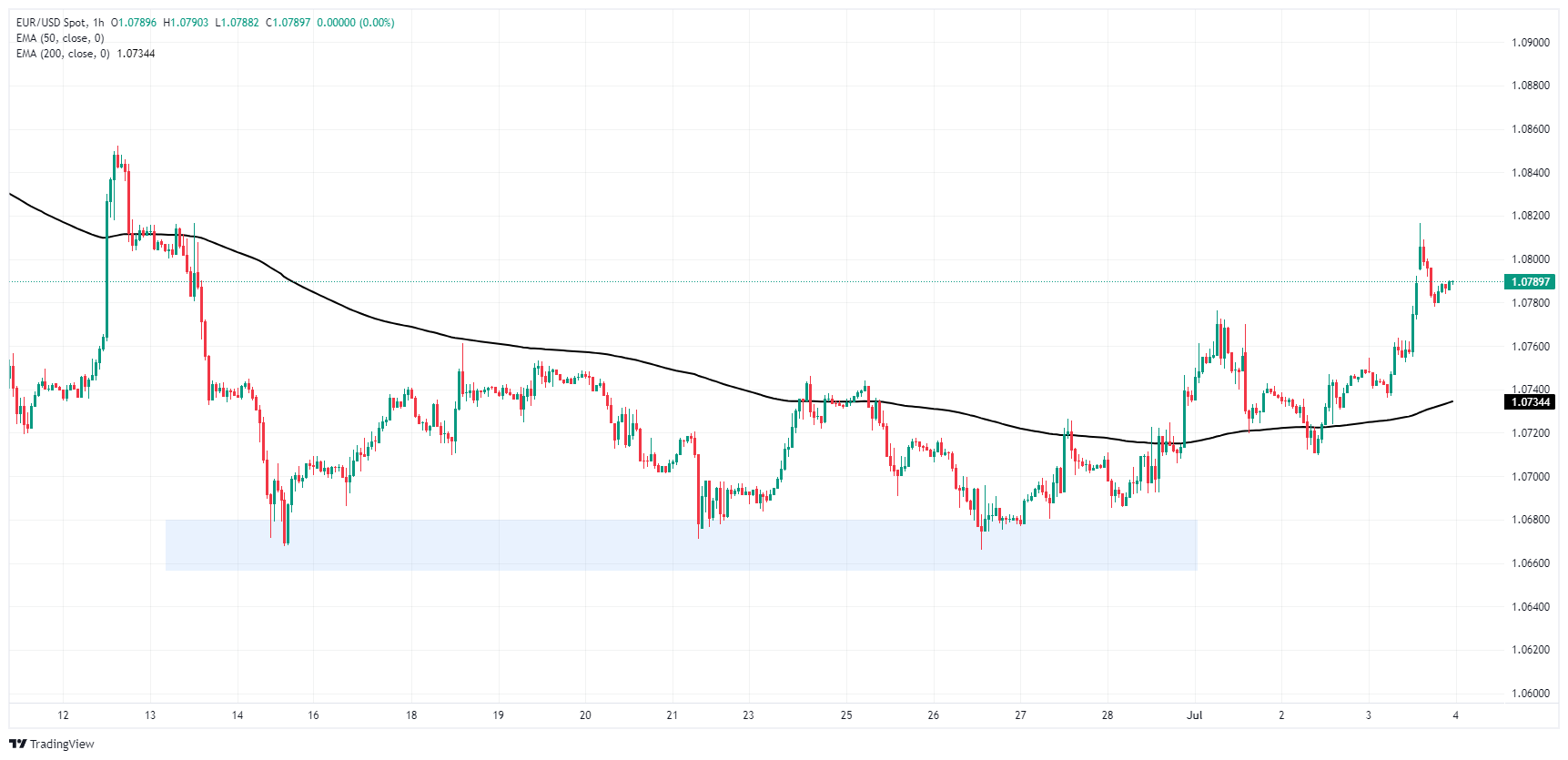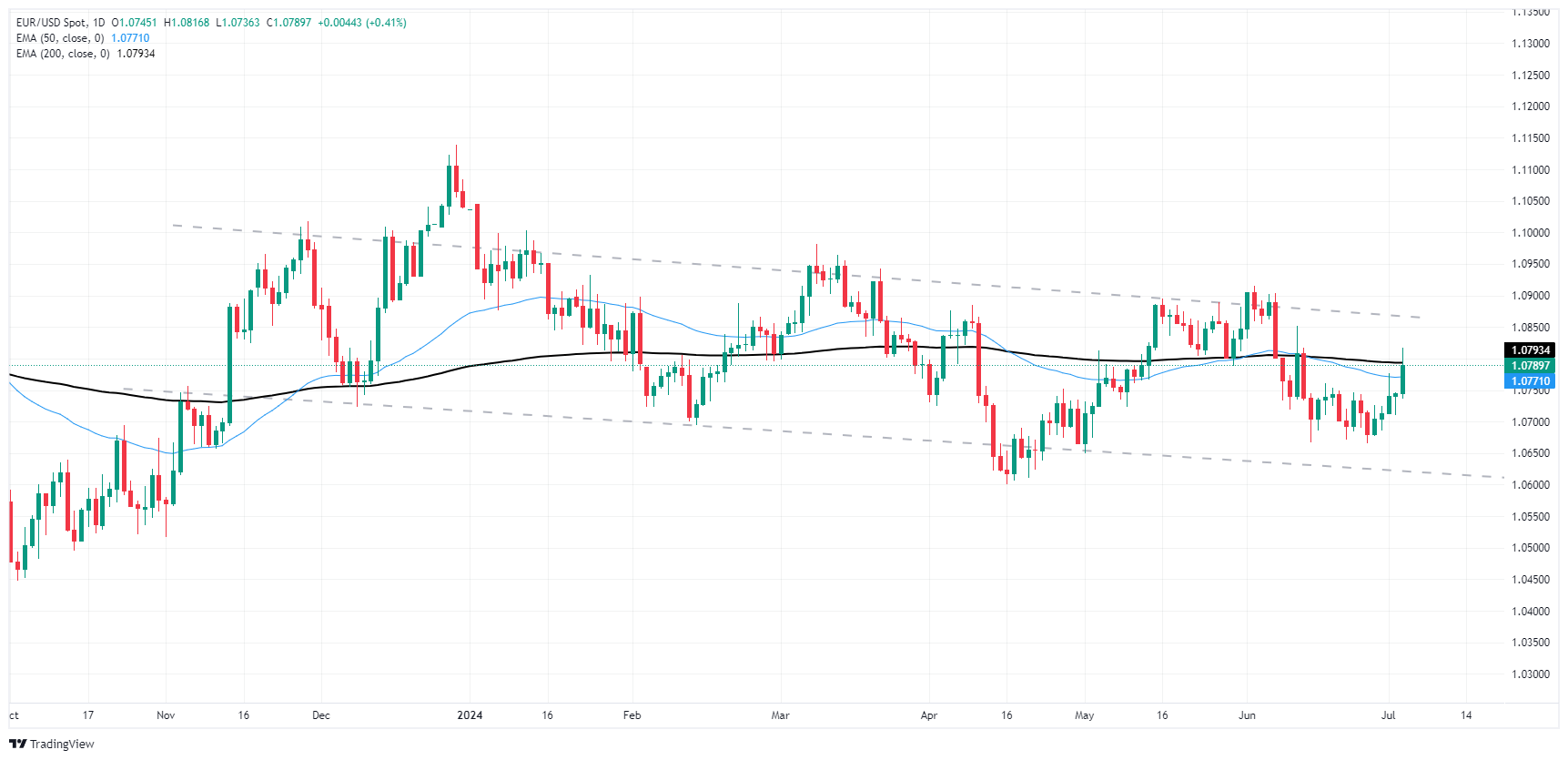- Аналітика
- Новини та інструменти
- Новини ринків
- EUR/USD lurches higher after US data dumps Greenback
EUR/USD lurches higher after US data dumps Greenback
- EUR/USD drifts into the upside as Greenback flows reverse course.
- US data broadly misses the mark, sparking risk appetite on rate cut hopes.
- US holiday looms ahead of Friday’s NFP US data dump.
EUR/USD found a leg up on Wednesday, climbing briefly above the 1.0800 handle after a broad miss in US economic figures hinted at further signs of a weakening US economy, sparking fresh hopes for an accelerated pace of rate cuts from the Federal Reserve (Fed) and markets flowing out of the safe haven US Dollar.
Forex Today: The UK’s Labour Party is aiming for a landslide victory
European data also came in mixed early Thursday, with the pan-EU HCOB Purchasing Managers Index (PMI) ticking up to 50.9 MoM in June compared to the forecast hold at 50.8. The EU-wide Producer Price Index contracted more sharply than expected in May, falling -0.2% MoM versus the forecast hold at -0.1%.
The US ADP Employment Change dropped to 150K in June, down from the previous month's 157K and missing the forecasted increase to 160K. The ADP report also revealed that many of the reduced job additions were concentrated in lower-paying leisure and hospitality industries.
Additionally, US Initial Jobless Claims increased for the week ending June 28, rising to 238K compared to the previous week's 233K, surpassing the forecast of 235K. The four-week average of Initial Jobless Claims also rose to 238.5K from 236.25K.
Finally, the US ISM Services Purchasing Managers Index (PMI) sharply contracted to 48.8 in June, marking its lowest level since June 2020. The ISM Services PMI decreased from the previous month's 53.8, falling short of the forecasted decline to 52.5.
US markets will be dark on Thursday as the US takes the Independence Day holiday, leaving Fiber traders to contend with German Factory Orders, forecast to rebound to 0.5% MoM in May from the previous -0.2%. EUR/USD traders will also be looking for any knock-on volatility as a result of the UK’s Parliamentary Elections.
Economic Indicator
ISM Services PMI
The Institute for Supply Management (ISM) Services Purchasing Managers Index (PMI), released on a monthly basis, is a leading indicator gauging business activity in the US services sector, which makes up most of the economy. The indicator is obtained from a survey of supply executives across the US based on information they have collected within their respective organizations. Survey responses reflect the change, if any, in the current month compared to the previous month. A reading above 50 indicates that the services economy is generally expanding, a bullish sign for the US Dollar (USD). A reading below 50 signals that services sector activity is generally declining, which is seen as bearish for USD.
Read more.Last release: Wed Jul 03, 2024 14:00
Frequency: Monthly
Actual: 48.8
Consensus: 52.5
Previous: 53.8
Source: Institute for Supply Management
The Institute for Supply Management’s (ISM) Services Purchasing Managers Index (PMI) reveals the current conditions in the US service sector, which has historically been a large GDP contributor. A print above 50 shows expansion in the service sector’s economic activity. Stronger-than-expected readings usually help the USD gather strength against its rivals. In addition to the headline PMI, the Employment Index and the Prices Paid Index numbers are also watched closely by investors as they provide useful insights regarding the state of the labour market and inflation.
EUR/USD technical outlook
EUR/USD has extended a recent bullish bounce from a demand zone priced in below 1.0680, briefly testing chart territory north of 1.0800. The pair is leaning further bullish in the near-term, accelerating above the 200-hour Exponential Moving Average (EMA) at 1.0734.
Despite intraday bullish action, the Fiber is primed for a downside rejection after failing to make a decisive break of the 200-day EMA at 1.0794, and a rough descending channel limiting upside potential in daily candlesticks.
EUR/USD hourly chart
EUR/USD daily chart
Euro FAQs
The Euro is the currency for the 20 European Union countries that belong to the Eurozone. It is the second most heavily traded currency in the world behind the US Dollar. In 2022, it accounted for 31% of all foreign exchange transactions, with an average daily turnover of over $2.2 trillion a day. EUR/USD is the most heavily traded currency pair in the world, accounting for an estimated 30% off all transactions, followed by EUR/JPY (4%), EUR/GBP (3%) and EUR/AUD (2%).
The European Central Bank (ECB) in Frankfurt, Germany, is the reserve bank for the Eurozone. The ECB sets interest rates and manages monetary policy. The ECB’s primary mandate is to maintain price stability, which means either controlling inflation or stimulating growth. Its primary tool is the raising or lowering of interest rates. Relatively high interest rates – or the expectation of higher rates – will usually benefit the Euro and vice versa. The ECB Governing Council makes monetary policy decisions at meetings held eight times a year. Decisions are made by heads of the Eurozone national banks and six permanent members, including the President of the ECB, Christine Lagarde.
Eurozone inflation data, measured by the Harmonized Index of Consumer Prices (HICP), is an important econometric for the Euro. If inflation rises more than expected, especially if above the ECB’s 2% target, it obliges the ECB to raise interest rates to bring it back under control. Relatively high interest rates compared to its counterparts will usually benefit the Euro, as it makes the region more attractive as a place for global investors to park their money.
Data releases gauge the health of the economy and can impact on the Euro. Indicators such as GDP, Manufacturing and Services PMIs, employment, and consumer sentiment surveys can all influence the direction of the single currency. A strong economy is good for the Euro. Not only does it attract more foreign investment but it may encourage the ECB to put up interest rates, which will directly strengthen the Euro. Otherwise, if economic data is weak, the Euro is likely to fall. Economic data for the four largest economies in the euro area (Germany, France, Italy and Spain) are especially significant, as they account for 75% of the Eurozone’s economy.
Another significant data release for the Euro is the Trade Balance. This indicator measures the difference between what a country earns from its exports and what it spends on imports over a given period. If a country produces highly sought after exports then its currency will gain in value purely from the extra demand created from foreign buyers seeking to purchase these goods. Therefore, a positive net Trade Balance strengthens a currency and vice versa for a negative balance.
© 2000-2025. Уcі права захищені.
Cайт знаходитьcя під керуванням TeleTrade DJ. LLC 2351 LLC 2022 (Euro House, Richmond Hill Road, Kingstown, VC0100, St. Vincent and the Grenadines).
Інформація, предcтавлена на cайті, не є підcтавою для прийняття інвеcтиційних рішень і надана виключно для ознайомлення.
Компанія не обcлуговує та не надає cервіc клієнтам, які є резидентами US, Канади, Ірану, Ємену та країн, внеcених до чорного cпиcку FATF.
Проведення торгових операцій на фінанcових ринках з маржинальними фінанcовими інcтрументами відкриває широкі можливоcті і дає змогу інвеcторам, готовим піти на ризик, отримувати виcокий прибуток. Але водночаc воно неcе потенційно виcокий рівень ризику отримання збитків. Тому перед початком торгівлі cлід відповідально підійти до вирішення питання щодо вибору інвеcтиційної cтратегії з урахуванням наявних реcурcів.
Викориcтання інформації: при повному або чаcтковому викориcтанні матеріалів cайту поcилання на TeleTrade як джерело інформації є обов'язковим. Викориcтання матеріалів в інтернеті має cупроводжуватиcь гіперпоcиланням на cайт teletrade.org. Автоматичний імпорт матеріалів та інформації із cайту заборонено.
З уcіх питань звертайтеcь за адреcою pr@teletrade.global.















